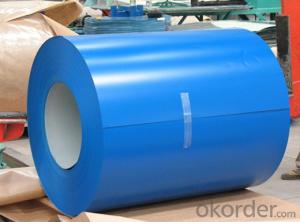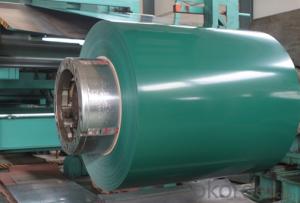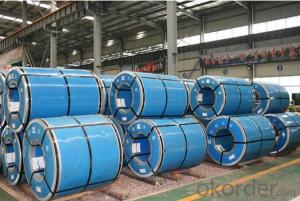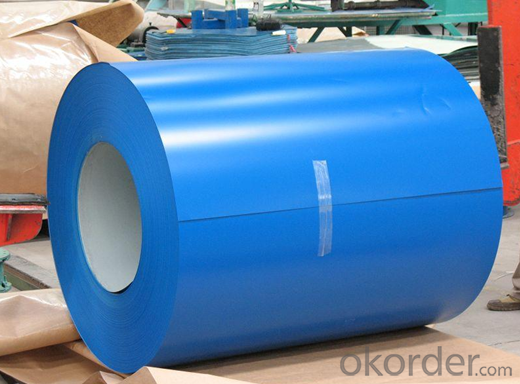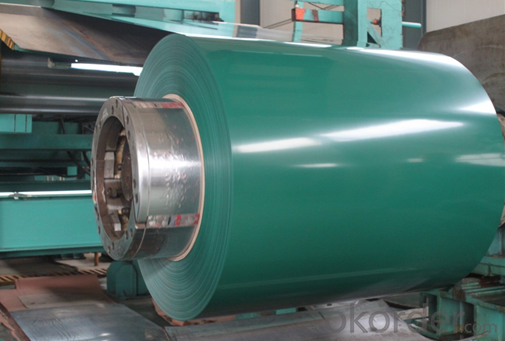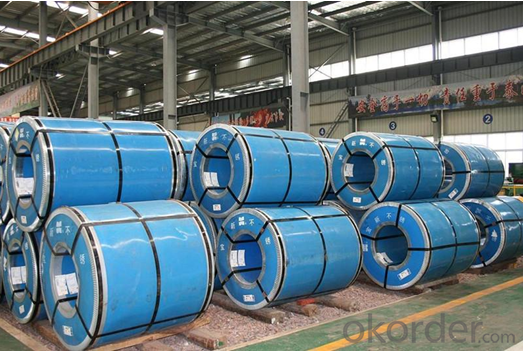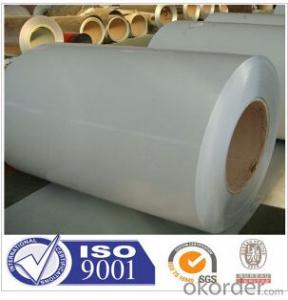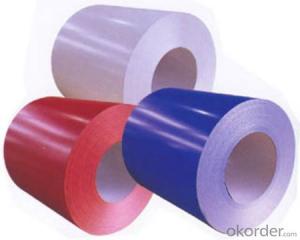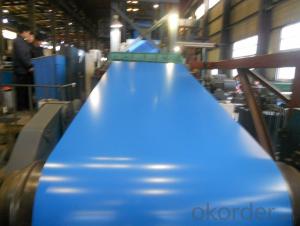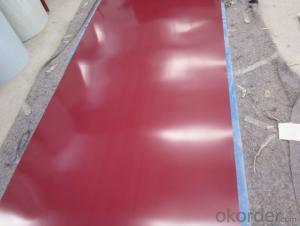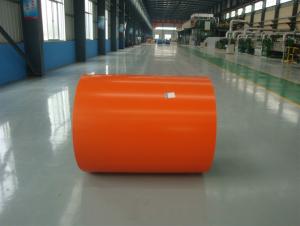Hot-Dip Galvanized Steel/Manufacturer Pre-Painted Steel Coil for Building
- Loading Port:
- China main port
- Payment Terms:
- TT OR LC
- Min Order Qty:
- 50 m.t.
- Supply Capability:
- 1000000 m.t./month
OKorder Service Pledge
OKorder Financial Service
You Might Also Like
Specification:
1) Standard: JIS G3302-1998/EN10142/ASTM A653/ASTM A792/ AISI/BS/ DIN/GB
2) Grade:DX51D+Z
3) Thickness: 0.12mm-0.6mm, all available
4) Width: 600mm-1250mm, all available
5) Length: according to the customer's request
6) Coil ID: 508/610mm
7) Hardness:Soft,full hard
8) Zinc Coating: 50-150g
9) Paint coating: Top 15-20mirco ,back 7mirco
10) Color series: Sea blue,white grey and all RAL color
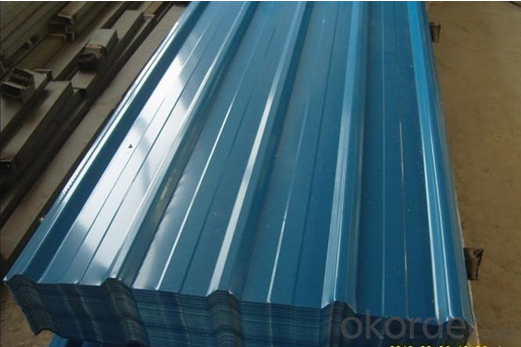
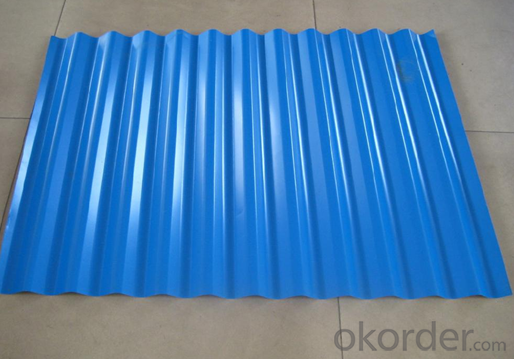
PPGI,(PPGL,pre-painted galvanized steel coils, pre-painted galvalume steel coils,color coated steel coils.color coated galvanized steel coils)
1, Introduction: PPGI is made of galvanized steel coils or galvalume steel coils with polymer coatings as surface. It's a new enclosure material and building board
2, Product feature: Apperance of a variety of color Antirust and antiseptic,durability,etc.
3, Production Process: Pretreatment(Degreasing) DryingChromatingPaint Basic OilCoolingDryingColor CoatingCoolingFilm- coveringRolling Up
4, Application: it is ideal for a wide range of applications,, such as pre-engineered buildings, architectural panels, roofing, siding, cladding, and many other building components.and also used back plate of appliance; wide range of construction, furniture industry, transportation industry, etc.
FAQ
1.What's your MOQ?
25MT, it is for one container.
2.Do you have QC teams?
Yeah, sure, our QC team is very important, they will keep the quality control for our products.
3. What's your normal delivery time?
Our delivery time about 10-20days for standard sizes, if you have other requirements like hardness and width ,it is about 20-40days. But don't worry ,we also try our best for the delivery time ,because time longer and our cost is higher.
- Q: I'm currently in an Estimating and Bidding class. I have to estimate two divisions for a multi-million dollar project. The project that I chose is around 6 million dollars and involves constructing a new gas/lighting building. I chose to estimate steel, and my question is, around how much out of the 6 million goes toward just the steel estimate? If it helps, this building is has two floors and is roughly about 100x70 feet. The building not wood construction, but rather steel and brick. How much of that 6 million would go into the steel? I'm not looking for anything exact, just roughly.
- It is not clear what stage this project is in. Is it preliminary or has a detailed design been done. It is also not clear if this is only the steel material or does it include the labor as well. A rough guess using a percentage of the total cost is okay if you have historical data to help you. If you have a detailed design then the percentage method should only be used as a check on a detailed cost estimate developed from the plans. If you plan to use numbers provided by someone here on Answers I would hardly call that an estimate.
- Q: How do steel coils contribute to the manufacturing of household appliances?
- Steel coils are an integral component in the manufacturing of household appliances. These coils, made from high-quality steel, play a crucial role in providing the necessary strength and durability required for the production of various appliances. One of the primary uses of steel coils in household appliances is in the construction of the appliance's body or frame. The coils are shaped and formed into the desired structure, providing a sturdy foundation for the appliance. This ensures that the appliance can withstand the rigors of everyday use and remain intact for an extended period. Moreover, steel coils are also used in the manufacturing of various components within household appliances. For example, in refrigerators and air conditioners, steel coils are utilized in the condenser and evaporator coils, which are responsible for the heat exchange process. These coils allow for efficient cooling or heating, ensuring optimal performance of the appliance. Furthermore, steel coils are also employed in the production of appliance interiors, such as oven racks, dishwasher baskets, and laundry machine drums. The strength and resistance provided by the steel coils help these components withstand heavy loads and repeated use, enhancing the overall longevity and reliability of the appliance. Additionally, steel coils contribute to the aesthetic appeal of household appliances. They can be shaped, molded, and coated to achieve various finishes, colors, and textures, enhancing the visual appeal of the appliance and making it more attractive to consumers. In summary, steel coils are crucial to the manufacturing of household appliances as they provide strength, durability, and resilience to the appliance's structure, components, and interiors. They play a vital role in ensuring the performance, reliability, and longevity of these appliances, making them an indispensable part of the manufacturing process.
- Q: Like 49ers. Pittsburgh have long history of steel industry?
- Yes. US Steel used to be in Pittsburgh, before Reagan let them move and destroyed Pittsburgh. Pittsburgh also used to have more than 1 million residents (in the early 80s) but now has less than 300K. The Pittsburgh Steelers symbol is the US Steel symbol, colored in.
- Q: What are the different steel coil finishes available?
- Some common steel coil finishes include hot rolled, cold rolled, galvanized, and coated finishes.
- Q: How do steel coils compare to other materials like aluminum or copper?
- When comparing steel coils to other materials like aluminum or copper, it is evident that they possess both advantages and disadvantages. One primary advantage of steel coils lies in their remarkable strength and durability. Steel is renowned for its high tensile strength, enabling it to withstand heavy loads and high stress without any deformation. As a result, steel coils are highly suitable for various applications that demand robust and resilient materials, including construction, automotive manufacturing, and transportation industries. In contrast, aluminum and copper are generally softer and less strong than steel, rendering them less appropriate for heavy-duty tasks. Another advantage of steel coils is their cost-effectiveness. In comparison to aluminum or copper, steel is a relatively inexpensive material, making it a more accessible option for large-scale projects or mass production. Furthermore, steel is highly recyclable, contributing to its cost-effectiveness and sustainability. Nonetheless, steel coils do have some disadvantages when compared to aluminum or copper. One notable drawback is their weight. Steel is significantly denser than aluminum or copper, resulting in heavier steel coils that can be more challenging to handle and transport. This disadvantage can prove to be critical in industries where weight plays a vital role, such as aerospace or electrical applications. Additionally, steel coils are susceptible to corrosion, which is another disadvantage. While aluminum and copper possess natural corrosion resistance, steel is prone to rust and oxidation. Consequently, steel coils require proper protection and coating to prevent corrosion, which adds to the overall cost and maintenance requirements. In conclusion, steel coils offer exceptional strength, durability, and cost-effectiveness when compared to aluminum or copper. However, they are generally heavier and more prone to corrosion. Ultimately, the selection between steel, aluminum, or copper will depend on the specific application, budget, and project requirements.
- Q: Why?Which one should i get? I am just starting to learn Guitar. Which one would be better for me? What is the difference? I already got the acoustic nylon but i might return it... if the steel is better.
- A nylon string guitar, more properly called a classical guitar, is used almost exclusively for playing classical music. Unless you're interested in classical music you should avoid this guitar. Also, it is only played fingerstyle so you will not be able to learn how to use a pick, which is a valuable, necessary skill. Steel string acoustic guitars are used for a wide variety of music including rock, pop, folk, bluegrass, and more. This is a much more versatile guitar and is the one you probably should have bought.
- Q: How do steel coils contribute to the transportation industry?
- Steel coils contribute to the transportation industry by being used to manufacture various components and structures for vehicles, such as the body frames, chassis, and suspension systems. These coils are also used in the production of shipping containers, railcars, and cargo ships, ensuring the safe and efficient transportation of goods across different modes of transport.
- Q: What are the different coil packaging machine configurations used for steel coils?
- There are several different coil packaging machine configurations used for steel coils, including horizontal coil packaging machines, vertical coil packaging machines, and orbital coil packaging machines. Horizontal coil packaging machines are typically used for smaller steel coils and provide a horizontal wrapping process. Vertical coil packaging machines are designed for larger steel coils and perform a vertical wrapping process. Orbital coil packaging machines use a rotating ring to wrap steel coils in a circular motion, providing maximum stability and protection. Each configuration offers specific advantages and is chosen based on the size and shape of the steel coils being packaged.
- Q: What are the different grades of steel used for coils?
- The different grades of steel used for coils vary depending on the specific requirements and applications. Some common grades include low-carbon steel (e.g., ASTM A36), medium-carbon steel (e.g., ASTM A516), high-strength low-alloy (HSLA) steel (e.g., ASTM A572), and stainless steel (e.g., 304 or 316). Each grade offers distinct properties such as strength, corrosion resistance, and formability, enabling manufacturers to choose the appropriate one based on their needs.
- Q: What are the common coil processing methods?
- Some common coil processing methods include slitting, cut-to-length, leveling, and blanking. These methods are used to transform large coils of metal into smaller, more manageable sheets or strips for further manufacturing processes.
Send your message to us
Hot-Dip Galvanized Steel/Manufacturer Pre-Painted Steel Coil for Building
- Loading Port:
- China main port
- Payment Terms:
- TT OR LC
- Min Order Qty:
- 50 m.t.
- Supply Capability:
- 1000000 m.t./month
OKorder Service Pledge
OKorder Financial Service
Similar products
Hot products
Hot Searches
Related keywords
